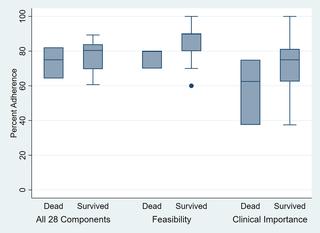Our official English website, www.x-mol.net, welcomes your
feedback! (Note: you will need to create a separate account there.)
Assessment of early goal-directed therapy guideline adherence: Balancing clinical importance and feasibility.
PLOS ONE ( IF 2.9 ) Pub Date : 2019-03-15 , DOI: 10.1371/journal.pone.0213802 Thansinee Saetae 1 , Krit Pongpirul 2, 3 , Rujipat Samransamruajkit 1
PLOS ONE ( IF 2.9 ) Pub Date : 2019-03-15 , DOI: 10.1371/journal.pone.0213802 Thansinee Saetae 1 , Krit Pongpirul 2, 3 , Rujipat Samransamruajkit 1
Affiliation

|
BACKGROUND
Assessing adherence to Early goal-directed therapy (EGDT) is challenging and might account for the negative findings and generalisability of the major trials to a real-life setting. This study was aimed (1) to extract key components of pediatric EGDT guidelines potentially becoming adherence criteria; (2) to classify adherence criteria into complete, clinically important, and feasible; and (3) to compare percent adherence to selected guidelines using the three approaches.
METHODS
This study started with review of existing evidence to extract key components of pediatric EGDT guidelines. Modified Delphi method was then conducted in two rounds among national experts to identify feasible and/or clinically important criteria. Data from the national prospective multicenter study "Clinical Effectiveness of the Utilization of Bundled Care for Severe Sepsis and Septicemia Children" at King Chulalongkorn Memorial Hospital (KCMH) during 1 June 2012 and 28 February 2014 was used to compare percentage of adherence across the three approaches.
RESULTS
Of 28 components extracted from the review, 10 were identified by the national experts through the Modified Delphi as feasible whereas 8 were identified as clinically important. Thirty-one severe sepsis patients (48.39% male, median age 3.4 years) were reviewed. Sepsis mortality was 9.7%, a significant reduction from 19% and 42% in 2010 and 2007, respectively. Based on the complete adherence criteria, the percent adherence varied from 60.71% to 89.29% (overall mean 76.84%), with lower adherence in the dead than the survived cases (73.81% vs 77.17%; p = 0.55). The percent adherence varied by criteria used: 69.35%, 76.84%, and 84.52% for clinical importance, complete, and feasibility criteria, respectively.
CONCLUSION
Adherence determination based on selected clinical importance alone might result in an incorrectly estimated clinical benefit of EGDT guidelines, especially in a resource-limited setting. Both clinical importance and feasibility should be integrated into the development of adherence assessment criteria.
中文翻译:

评估早期目标导向治疗指南的遵守情况:平衡临床重要性和可行性。
背景评估早期目标导向治疗(EGDT)的依从性具有挑战性,并且可能解释主要试验的负面结果和对现实生活环境的普遍性。本研究的目的是 (1) 提取儿科 EGDT 指南的关键组成部分,有可能成为依从标准; (2) 将依从性标准分为完整的、临床上重要的和可行的; (3) 比较使用三种方法对选定指南的遵守百分比。方法 本研究首先回顾现有证据,提取儿科 EGDT 指南的关键组成部分。然后,修改后的德尔菲法在国家专家中进行了两轮,以确定可行和/或临床上重要的标准。使用 2012 年 6 月 1 日至 2014 年 2 月 28 日期间在朱拉隆功国王纪念医院 (KCMH) 进行的国家前瞻性多中心研究“对严重脓毒症和败血症儿童使用捆绑护理的临床有效性”的数据来比较三种方法的依从性百分比。结果在审查中提取的28个成分中,10个被国家专家通过改良德尔菲法确定为可行,8个被确定为具有临床重要性。对 31 名严重脓毒症患者(48.39% 男性,中位年龄 3.4 岁)进行了回顾。脓毒症死亡率为 9.7%,比 2010 年和 2007 年分别为 19% 和 42% 显着下降。根据完全依从性标准,依从性百分比从 60.71% 到 89.29% 不等(总体平均值为 76.84%),死亡病例的依从性低于存活病例(73.81% vs 77.17%;p = 0.55)。依从性百分比因所使用的标准而异:临床重要性、完整性和可行性标准分别为 69.35%、76.84% 和 84.52%。 结论 仅根据选定的临床重要性来确定依从性可能会导致错误地估计 EGDT 指南的临床益处,特别是在资源有限的环境中。临床重要性和可行性都应纳入依从性评估标准的制定中。
更新日期:2019-03-17
中文翻译:

评估早期目标导向治疗指南的遵守情况:平衡临床重要性和可行性。
背景评估早期目标导向治疗(EGDT)的依从性具有挑战性,并且可能解释主要试验的负面结果和对现实生活环境的普遍性。本研究的目的是 (1) 提取儿科 EGDT 指南的关键组成部分,有可能成为依从标准; (2) 将依从性标准分为完整的、临床上重要的和可行的; (3) 比较使用三种方法对选定指南的遵守百分比。方法 本研究首先回顾现有证据,提取儿科 EGDT 指南的关键组成部分。然后,修改后的德尔菲法在国家专家中进行了两轮,以确定可行和/或临床上重要的标准。使用 2012 年 6 月 1 日至 2014 年 2 月 28 日期间在朱拉隆功国王纪念医院 (KCMH) 进行的国家前瞻性多中心研究“对严重脓毒症和败血症儿童使用捆绑护理的临床有效性”的数据来比较三种方法的依从性百分比。结果在审查中提取的28个成分中,10个被国家专家通过改良德尔菲法确定为可行,8个被确定为具有临床重要性。对 31 名严重脓毒症患者(48.39% 男性,中位年龄 3.4 岁)进行了回顾。脓毒症死亡率为 9.7%,比 2010 年和 2007 年分别为 19% 和 42% 显着下降。根据完全依从性标准,依从性百分比从 60.71% 到 89.29% 不等(总体平均值为 76.84%),死亡病例的依从性低于存活病例(73.81% vs 77.17%;p = 0.55)。依从性百分比因所使用的标准而异:临床重要性、完整性和可行性标准分别为 69.35%、76.84% 和 84.52%。 结论 仅根据选定的临床重要性来确定依从性可能会导致错误地估计 EGDT 指南的临床益处,特别是在资源有限的环境中。临床重要性和可行性都应纳入依从性评估标准的制定中。











































 京公网安备 11010802027423号
京公网安备 11010802027423号